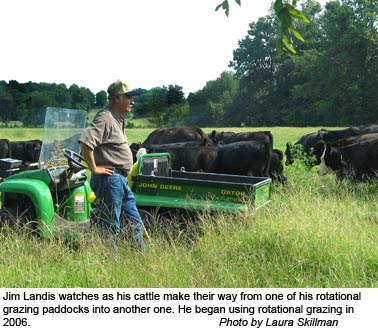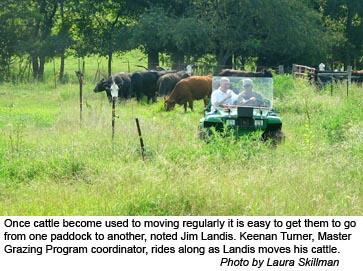Barren County Farm Spotlights UK Grazing Program
Barren County Farm Spotlights UK Grazing Program

With the state in the throes of a severe drought and many of his neighbors already feeding hay, Barren County farmer Jim Landis pauses in nearly foot-tall grass to reflect on a grazing plan he initiated last year.
Landis said he only has 120 acres and getting additional land around him is difficult so he decided to do the best with what he had – get the most out of each acre and utilize it and not waste it.
“The University of Kentucky College of Agriculture came along with the Master Grazing Program, and my wife (Baker) and I got involved with it, and it’s worked out perfectly for us,” he said.
The Landis family took their once large grain and hay fields and divided them into 22 smaller paddocks where he grazes his fall and spring cattle herds that total 101 cows. He also added several in-field waterers for the cattle to keep them within 800 feet of their water supply and ensured that shade was also available in each paddock.
The farm is one of 19 demonstration farms in the UK Master Grazing Program, said Keenan Turner, program coordinator. The program began in January 2006 and is funded through the Kentucky Beef Network with tobacco settlement money. The program consists of five classroom sessions followed by a field day at one of the demonstration farms across the state. People interested in attending the program should contact their county office of the UK Cooperative Extension Service.
“The bottom line is we’ve found out that every day that you can graze is cheaper than mechanically harvested and stored feed on the farm or purchased feed,” Turner said. “Farmers like that. They are always looking for ways to reduce expenses, and we think we have a program that can help them do that.”  The Landis farm is a perfect example of how good management – rotating pastures with ample water and shade – can mean having plenty of pasture even in a drought year, Turner said.
The Landis farm is a perfect example of how good management – rotating pastures with ample water and shade – can mean having plenty of pasture even in a drought year, Turner said.
Landis said he likes to move the cattle when the pastures are still three to four inches tall, because the growth will come back more quickly than if the cattle are allowed to graze it into the ground.
“We switch them whenever we need to, sometimes from day to day, and sometimes there are three or four days before we move them,” he said. “In 2006, we moved them 96 times and so far this year, 50 times. We try to pull them off when many people may be just getting ready to put theirs on.”
Once the paddocks are established, it does not take long to train the cattle to move, Landis said. He simply opens a gate, drives through and they quickly follow. It makes it easier to get them to the barn when it’s time to work them, and it helps him to keep a better check on the cattle, so if there’s any problem he can deal with it more quickly.
What hay he cuts comes from paddocks where the grass is growing too quickly for the cattle to graze. Landis said he does not plan to feed much hay, preferring to let the cattle graze. This is cheaper and returns the undigested nutrients back to the soil through the manure.
In the past, Landis said he’s begun feeding hay as early as September and with this year’s drought many of his neighbors are already doing so. But, he’s hoping to be able to pasture his cattle into January and possibly February by stockpiling some of the paddocks for this winter.
“2007 has been a perfect year to test the rotational grazing program,” he said. “Where most people are out of pasture, our cattle were fed better this year than they’ve ever been and still have plenty to go on into winter. In a good year, anyone can have grass, but in a year like this it takes management.”
Landis is a believer in the grazing program and has completed the UK Master Cattleman Program as well. He said UK has a wealth of information for farmers and encourages more people to turn to them for their expertise.
Barren County is the largest cattle county in the state in both beef and dairy and many farmers are looking for ways to improve the forage and grazing programs, so having a demonstration farm in the county is a real plus, said Gary Tilghman, Barren County extension agent for agricultural and natural resources.
“It’s a good show and tell,” he said, “when you can bring a producer out here and show them, and they can talk to Mr. Landis. Once they get away from the thought that there’s a lot of labor in it – there’s really a lot of planning and developing a system that works good – and they can see that it is really helpful.
“The Landis’s are great friends and great cooperators,” he said. “They don’t mind visitors, and others can see what they are doing first hand and say, ‘Hey I can do that.’”
